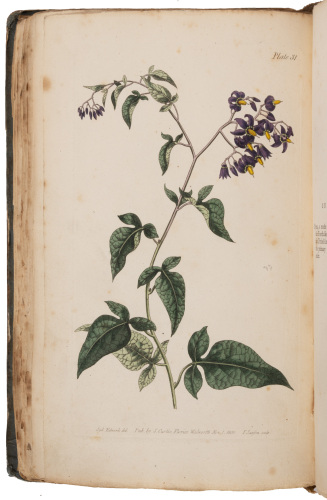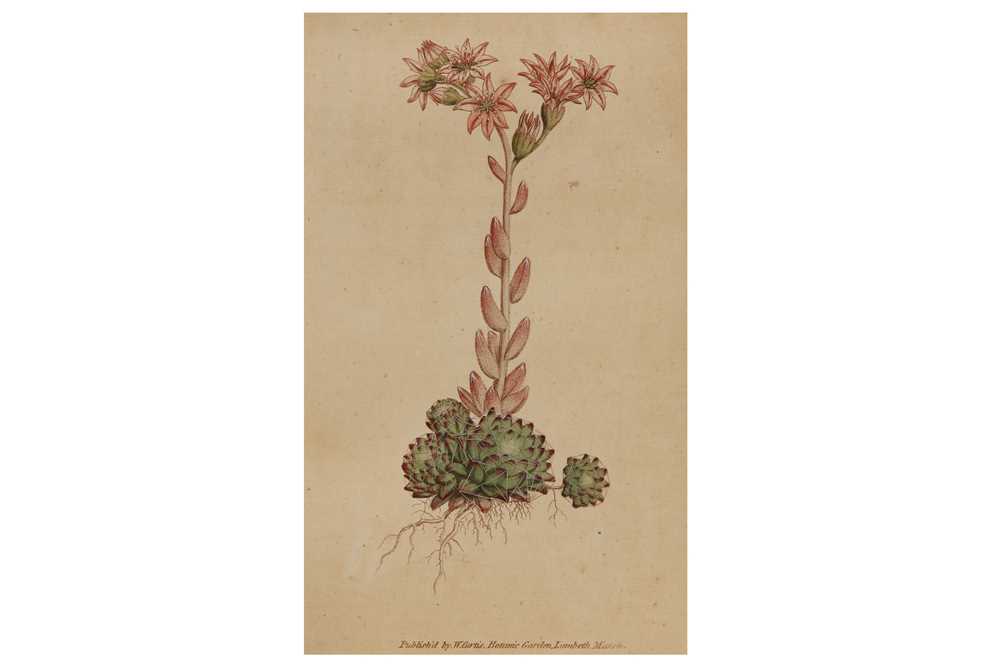WILLIAM CURTIS (1746-1799) Flora Londiniensis; or, Plates and Descriptions of such Plants as grow wild in the Environs of London. London: printed for and sold by the Author and B.White & Son, [1775]-1777-1798. 2 volumes, 2° (480 x 287mm). Engraved oval vignette on title of vol.I, 435 (on 432) hand-coloured engraved plates on 432 leaves after Sydenham Edwards, James Sowerby and William Kilburn (Occasional light browning or spotting to plates, more obtrusive to about ten plates, occasional light offsetting of text onto plates.) Contemporary diced russia gilt, covers with gilt border and the later applied arms of William, Earl of Dartmouth, spines gilt (spines scuffed with joints and head and foot repaired). Provenance : WILLIAM LEGGE, 6TH EARL OF DARTMOUTH (1851-1936); John Stewart Roberts (book-labels). A FINE COPY OF THE FIRST EDITION with the second issue title to volume I. The Flora Londiniensis is the first English flora illustrated with coloured plates to be at all comprehensive, and led indirectly to the foundation of the greatest of all botanical periodicals. Curtis, with the support of Lord Bute, published the first part in 1777, for "ten years he continued perserveringly at his congenial but unremunerative task; by 1787, the results of his labours were two splendid folio volumes and a deficit which made the continuance of his venture impossible. He understood the cause of the trouble and saw the remedy: if his clients refused to buy folio pictures of the unassuming plants that grew by the wayside, he would win their patronage with octavo engravings of the bright exotics which filled their gardens. Thus, in 1787, the Botanical Magazine was born." (Blunt The Art of Botanical Illustration 1994, p.212). The success of the magazine allowed for the continued publication of the Flora.. , the former providing "pudding" (as Curtis put it), the latter critical acclaim from his peers. This copy is without the second subscribers' list and the general indices to fasicles 4-6 (both required for a perfect copy, but often lacking). However, it does have all the other preliminary text, including the catalogue of plants around Settle and the observations on grasses. Great Flower Books p.54; Henrey III, 595; Hunt 650; Nissen BBI 439; Stafleu & Cowan 1286. (2)
WILLIAM CURTIS (1746-1799) Flora Londiniensis; or, Plates and Descriptions of such Plants as grow wild in the Environs of London. London: printed for and sold by the Author and B.White & Son, [1775]-1777-1798. 2 volumes, 2° (480 x 287mm). Engraved oval vignette on title of vol.I, 435 (on 432) hand-coloured engraved plates on 432 leaves after Sydenham Edwards, James Sowerby and William Kilburn (Occasional light browning or spotting to plates, more obtrusive to about ten plates, occasional light offsetting of text onto plates.) Contemporary diced russia gilt, covers with gilt border and the later applied arms of William, Earl of Dartmouth, spines gilt (spines scuffed with joints and head and foot repaired). Provenance : WILLIAM LEGGE, 6TH EARL OF DARTMOUTH (1851-1936); John Stewart Roberts (book-labels). A FINE COPY OF THE FIRST EDITION with the second issue title to volume I. The Flora Londiniensis is the first English flora illustrated with coloured plates to be at all comprehensive, and led indirectly to the foundation of the greatest of all botanical periodicals. Curtis, with the support of Lord Bute, published the first part in 1777, for "ten years he continued perserveringly at his congenial but unremunerative task; by 1787, the results of his labours were two splendid folio volumes and a deficit which made the continuance of his venture impossible. He understood the cause of the trouble and saw the remedy: if his clients refused to buy folio pictures of the unassuming plants that grew by the wayside, he would win their patronage with octavo engravings of the bright exotics which filled their gardens. Thus, in 1787, the Botanical Magazine was born." (Blunt The Art of Botanical Illustration 1994, p.212). The success of the magazine allowed for the continued publication of the Flora.. , the former providing "pudding" (as Curtis put it), the latter critical acclaim from his peers. This copy is without the second subscribers' list and the general indices to fasicles 4-6 (both required for a perfect copy, but often lacking). However, it does have all the other preliminary text, including the catalogue of plants around Settle and the observations on grasses. Great Flower Books p.54; Henrey III, 595; Hunt 650; Nissen BBI 439; Stafleu & Cowan 1286. (2)















Testen Sie LotSearch und seine Premium-Features 7 Tage - ohne Kosten!
Lassen Sie sich automatisch über neue Objekte in kommenden Auktionen benachrichtigen.
Suchauftrag anlegen